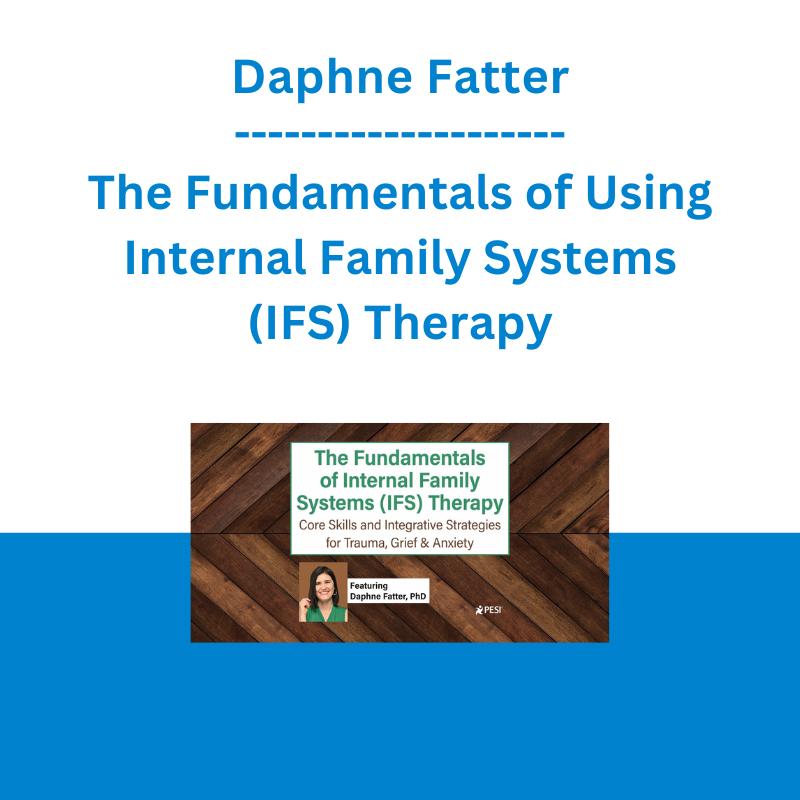*** Proof of Product ***
Exploring the Essential Features of “Daphne Fatter – The Fundamentals of Using Internal Family Systems (IFS) Therapy: Core Skills and Integrative Strategies for Trauma, Grief & Anxiety”
IFS therapy has gained widespread recognition — heralded as one of the most effective and groundbreaking approaches available.
By recognizing that individuals are made up of multiple parts, each with their own thoughts, emotions, and behaviors, IFS therapy transforms your practice and allows you to work with clients on a much-deeper level…
And now, in this comprehensive online course, you can get the perfect introduction to IFS therapy where you’ll not only discover the fundamental principles, but take away tools you can start using right away.
You’ll join Daphne Fatter, PhD, a Certified IFS Therapist and Clinical Consultant who completed her post-doctoral studies under Bessel van der Kolk.
Dr. Fatter will make it easy to get started with clear explanations and detailed guidance on using the IFS approach. She’ll show you how you can use the IFS model to improve your assessment and treatment of trauma, anxiety, and grief — and even how to integrate it with EMDR. PLUS you’ll get incredible bonus modules featuring IFS therapy experts Frank Anderson, Alexia Rothman, and Deran Young.
Don’t wait — register today and discover the groundbreaking power of IFS therapy.
Your Course Expert
Daphne Fatter, PhD, is a licensed psychologist, certified Internal Family Systems (IFS) therapist, and clinical IFS consultant. She is also certified in EMDR and has completed advanced training in cognitive processing therapy. Dr. Fatter completed a postdoctoral fellowship in clinical psychology at the Trauma Center, an affiliate of the Boston University School of Medicine, under the direct supervision of Dr. Bessel van der Kolk. In addition to her practice, Dr. Fatter trains mental health clinicians internationally providing engaging continuing education on nuances on trauma treatment from her seasoned clinical experience treating PTSD and complex trauma.
Here’s What You’ll Learn
Module 1
Skills and Techniques of IFS Therapy to Use Now
Start this course with Dr. Fatter walking you through the foundations of IFS therapy, step-by-step. She’ll ensure you fully understand the model and how to start applying it to assessment and the treatment of anxiety, grief, and trauma.
Steps of IFS Therapy and How to Get Started
- How using IFS therapy will meet your clients’ goals
- Understand different parts of your clients’ internal system
- Parts Led Systems vs Self-Led Systems
- Understanding Cultural Identities and Intersectionality
- The difference in IFS assessment and treatment planning
- Develop a relationship with clients’ core self and develop self-leadership skills
- Facilitating communication and collaboration between parts
- Guided Experiential
IFS Therapy for Anxiety: Working with Anxious Parts to Reduce Intensity
- How using IFS therapy shifts a client’s relationship with anxiety and reduces symptoms
- Identify “worrier” or “perfectionist” parts that activate in response to anxiety triggers
- Facilitate communication with anxious parts to understand their motivations
- Unburden exiled parts and release blocked or stuck anxiety-related emotions
- Practice self-compassion and self-care to reduce anxiety over time
- Case Examples
Provide Stability and Support for Clients Navigating the Grieving Process
- The latest grief research and diagnosis criteria
- Self-leadership to provide a sense of inner stability through the grieving process
- Exiles in grief and how they can be accessed and worked with in IFS therapy
- Addressing common protectors, such as avoidance, dissociation, and numbing
- Integration of Art, Writing, Ritual & Cultural Practices
- Identify and process secondary losses
- Work with acute loss, ambiguous grief, prolonged grief disorder
- Intergenerational Trauma: Legacy Burdens & Grief
IFS Therapy for Trauma, PTSD and Complex Trauma
- How IFS therapy differs in emotion regulation strategies from other approaches
- Overcome common therapist missteps
- Address trauma-related fears and concerns by working with protective parts
- Work with exiles to help clients process and heal from traumatic experiences
- Developing self-leadership in clients to increase their resilience and coping skills
- Help clients release emotional and physical trauma stored in the body
- Target Intergenerational, collective and ancestral trauma
Additional Considerations: Group Therapy, Medication, Vicarious Trauma & More
- Limitations of the Research & Potential Risks
- Using IFS therapy in Groups
- The Therapeutic Relationship, Countertransference, Vicarious Trauma, & Burnout
- Therapist Self-Disclosure
- Medications in IFS therapy
Module 2.
Integrating EMDR & IFS Therapy for Enhanced Trauma Processing
Now that you understand the essentials, Dr. Fatter will show you how IFS therapy and EMDR can be used together for more comprehensive trauma healing.
EMDR and IFS Therapy: Shared Principles and Why Memory Consolidation is Key
- Maximize memory reconsolidation fast
- Determine factors to integrate EMDR & IFS
- Easily identify appropriate client candidates
- Go beyond Single-Model Approaches for new success
Setting Up Effective IFS Therapy-Informed EMDR
- Apply an IFS therapy Paradigm Shift into EMDR
- How to use Bilateral Stimulation
- The 2 Choice Points Within the IFS therapy steps to Integrate EMDR
- Phase 1: History Taking, Treatment Planning, & Consent for Treatment Plan
- Phase 2: Preparation & Resource Development
- Introduce Self Tapping for Attachment Readiness and Repair
- Benefits & Risk of Integrating IFS therapy into EMDR’s 8-Phase Protocol
Inviting Self Presence into EMDR: Enhanced Assessment and More Comprehensive Trauma Processing
- Find Targets for Trauma Processing: EMDR vs IFS methods
- Internal Relational Repair for Healthier Relationships with Themselves and Others
- Phase 3: Assessment — Using IFS therapy to Help Identify Targets
- Phase 4: Desensitization — Using IFS Techniques for More Comprehensive Traumatic Material Processing
Practical IFS-Informed Interventions to Support Integration
- Phase 5: Install Positive Qualities to Counterbalance Negative Beliefs or Emotions
- Phase 6: Enhancing Sense of Safety and Trust in their Bodies
- Phase 7: Closure — How Understanding Parts Helps Clients Reflect on Progress
- Phase 8: Re-evaluation
BONUS!
Using IFS Therapy and Polyvagal Theory: Healing Through Compassionate Connection
Alexia (Lexi) D. Rothman, Ph.D.
Polyvagal Theory and IFS work together to calm your client’s nervous system so they can dive deep into themselves and resolve conflicts. You’ll learn how to keep your clients grounded and feeling safe in their bodies as you gently encourage them to process trauma and strong emotions. In this session, you will…
- Discover how IFS allows us to work in a Polyvagal-informed way to help clients heal
- Learn IFS therapy strategies to shift your clients’ nervous systems towards regulation and help them access their own capacity for healing
- Explore how to help your clients develop attuned, trusting relationships with their hyperaroused and hypoaroused parts
- Discuss real video examples of how to seamlessly integrate IFS therapy and PVT in treatment
Healing Cultural Trauma with IFS Therapy: A Culturally Sensitive Approach
Deran Young, LCSW
Use the IFS framework in this recording offers practical skills to help heal the traumatic wounds of oppression. Discover how to:Use the Intercultural
- Development Continuum with clients to explore how cultural perspectives impact communication and conflict style
- Apply the IFS model to help heal trauma, and acknowledge and own the parts of ourselves that become reactive when discussing issues of diversity
- Increase your ability to avoid microaggressions and help clients explore emotional wounds with culturally sensitive techniques including, “The U-turn” and “Unblending”
Embracing Suicidal Parts with IFS Therapy
Frank Anderson, MD
This bonus module offers you a practical exploration of how to approach suicidal ideation and behaviors from an IFS approach. Examining the pieces of the psyche that drive these thoughts, feelings, and actions, so you can encourage clients to make peace with, embrace, and find love for suicidal parts.
- Demonstrate the basics and foundational principles of IFS
- Conceptualize IFS theory as an intervention for suicidality
- Practice aspects of coping through the IFS approach for suicidal parts management
The Internal Family Systems (IFS) Flip Chart: A Psychoeducational Tool for Unlocking the Incredible Healing Potential of the Multiple Mind
Colleen West, LMFT
- In this unique flipchart, you’ll find:23 full-color, interactive client-facing pages
- Additional explanations and sample scripts on each corresponding therapist-facing page
- Dry-erase client pages for easy markup, customization, and reuse
The simple and easy-to-use design makes it ideal for working with clients to reduce or resolve:
Anxiety, panic, and phobias • Anger and rage • Depression • Posttraumatic stress disorder (PTSD) • Complex & Complicated grief • Substance use, addictions and compulsive behaviors and OCD • Unexplained physical symptoms and chronic illness • Childhood trauma and neglect • Disordered eating
Please see the full list of alternative group-buy courses available here: https://lunacourse.com/shop/









